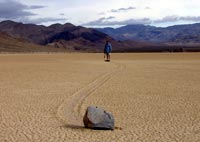Getting
Out There: |
Directory of all "Getting Out There" Articles> |
Racetrack Playa & the Mysterious Sliding Stones
by Mark Sedenquist
|
While I have seen passenger vehicles of all kinds out at the Racetrack playa, a truck or SUV with good ground clearance is the best choice for making the journey. The first two-and-a-half miles can be very rough and treacherous because of erosion from spring rain storms, especially for those who lack off-highway travel expertise. Regardless of vehicle type, it's also wise to lower tire pressures to a range of 20 to 25 psi (depending upon the type and condition of the tires). Lowering air pressure allows tires to "float" over sharp stones and sandy places and also increases the "footprint" of the tires which increases traction. Of course, upon return to the hard paved road, tires must be reinflated for safe travel on the highway. I use compressed CO2 in a Power Tank for this task, but inexpensive DC-powered air compressors work fine, too. Failure to lower tire pressure can lead to shredded tires, broken steering assemblies, not to mention a very uncomfortable ride.
After "airing-down" my tires to 22 pounds, I headed down the trail. It's a very bumpy twenty-six miles of washboard and sharp rocks to Tea Kettle Junction. I don't how long people have been hanging tea kettles on the sign there, but the array and the notes are great fun to look at. The Park Service polices this junction and keeps the "contributions" to a pleasing number. From Teakettle Junction, the route to the southeast crosses through Lost Burro Gap (a gorgeous "secret passage" to Hidden Valley) and eventually to Hunter Mountain Road and down into the Saline Valley. The limestone rock found in the area around Lost Burro Gap is full of fossils, and we have also seen many Indian petroglyphs and other ancient rock graffiti.
But our mission today was to continue towards the southwest on Racetrack Valley Road another six miles to the edge of the dry lake bed. At the first parking area, we walked out to the impressive basalt intrusions known as "The Grandstand," where we began to see some of the tracks left by sliding stones. No one really knows for sure what the mechanism is that causes these stones weighing as little as a few ounces or as much as 300 pounds to begin their mysterious and sometimes circuitous slides across the playa, but plenty of scientists and amateur geologists have come to this isolated lake bed and formed theories. Some have postulated that the movement is caused by a combination of triple-digit winds, ice sheets and slippery mud. Scientists like to use terms like "threshold coefficients of static friction," but the rest of us can more easily relate to terms like "slicker than snot." To date, no one has actually witnessed the stones moving. This is in part because when the extreme weather conditions that could lead to movement occur, no human wanting to stay healthy and alive should be anywhere nearby.
Most of the sliding stones can be found at the extreme southern end of the lake bed, where there is another parking area about six miles south of the first one. To see the best stones requires a fifteen-minute walk (at least) across the mosaic-like surface of the dry lake.
Perhaps the best explanation of how and why the stones move on the playa is in this UC San Diego/Scripps Intitute of Oceanography article published in August, 2014.
Next: The Lippincot Mine Road>
Mark Sedenquist
April 23, 2006





